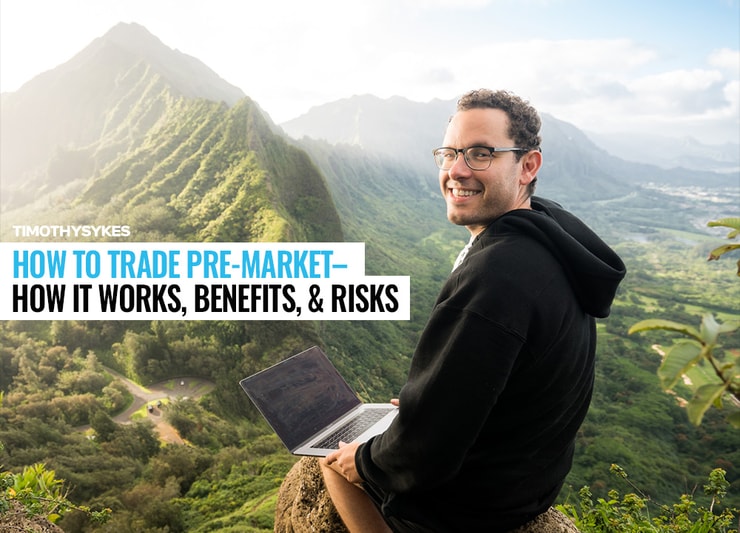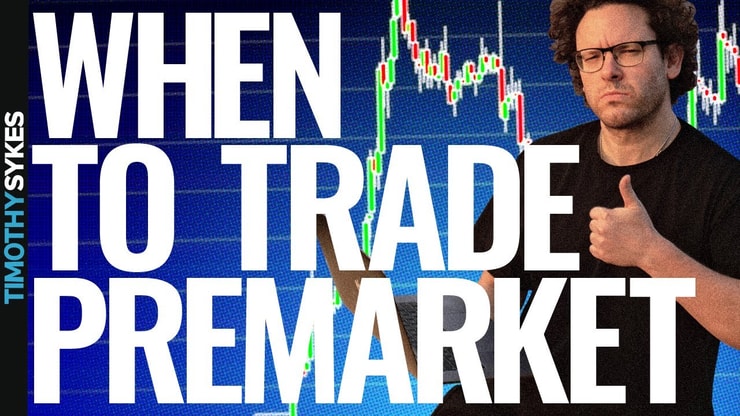Trading stocks in the pre-market session can be a strategic move for experienced traders. It’s a time when the stock market reacts to overnight news, earnings reports, and changes in the global economy.
However, I almost never trade pre-market. I don’t recommend it for newer traders, or anyone whose performance and chart skills aren’t top-notch…
The pre-market session, which takes place before the Nasdaq and other exchanges open for regular trading, often sees fewer traders and less liquidity, leading to potentially larger price swings. These price swings might go against you — if you’re left without buyers and have to hold a security past the point you should.
This article will delve into pre-market trading, the markets it works in, strategies, and purposes of this style of trading.
Table of Contents
What Is Pre-Market Trading?

Pre-market trading refers to the trading activity that occurs before the regular market session begins. It’s a time when investors can react to news events and company announcements that occur outside of regular market hours. For example, earnings reports are often released in the pre-market session, giving investors a chance to trade based on this new information.
However, pre-market trading isn’t for everyone. It comes with its own set of risks, including lower liquidity and higher volatility. But for those who know how to navigate these waters, pre-market trading offers some unique advantages.
Understanding the mechanics of pre-market trading is just the first step in your trading journey. It’s equally important to familiarize yourself with the tools that can aid your trading decisions. A reliable trading platform for day traders can provide you with the necessary features to effectively navigate the pre-market session. Explore this resource to learn more about the platforms that can help you succeed in your trading endeavors.
Benefits of Pre-Market Trading
One of the main benefits of pre-market trading is the ability to react to news events before the regular market opens. This can give savvy investors a head start, allowing them to take positions based on the latest information.
Another benefit is the potential for less competition. Because pre-market trading requires a certain level of expertise and access, there may be fewer traders to compete with. This can sometimes result in more favorable prices for those who know what they’re doing.
Risks Associated With Pre-Market Trading
Despite its benefits, pre-market trading also comes with significant risks. One of the main risks is lower liquidity. Because there are fewer traders in the pre-market session, it can be harder to buy or sell shares without impacting the price.
Another risk is higher volatility. With fewer shares being traded, prices can move more dramatically. This can be a double-edged sword, offering the potential for higher profits but also greater losses.
Pre-market trading can be very challenging for beginners — check out this video before you give it a try!
Strategies for Pre-Market Trading
While having a solid strategy for pre-market trading is crucial, it’s equally important to understand the basics of day trading. This includes knowing when to enter and exit trades, how to manage risk, and how to analyze market trends. To enhance your understanding of these concepts, consider reading this comprehensive guide on day trading basics. It provides valuable insights that can help you develop a robust trading strategy.
When it comes to pre-market trading, having a solid strategy is key. Here are some strategies to consider.
Monitor Earnings Reports and News Stories
One of the most common strategies for pre-market trading is to monitor earnings reports and news stories. Companies often release earnings reports in the pre-market session, and these reports can have a significant impact on a stock’s price. By staying on top of these reports, you can make informed trading decisions before the regular market opens.
The only time I trade pre-market is when a big story hits. Check this out…
Look at this BEAUTIFUL premarket chart of $GRNQ and recognize it more than doubled after the @sttbreakingnews alert I sold wayyyyy too soon I THE $1.60S, still making nearly $2k! Go signup at https://t.co/9qqyKfKepD right now, stop wasting gimme opportunities like this, my God! pic.twitter.com/RxZiHpnPyy
— Timothy Sykes (@timothysykes) October 5, 2020
I got the scoop from Breaking News Chat, one of the best add-on products for StocksToTrade.
I made a quick $1,625 (starting stake $8,905). This is a similar business to Elon Musk’s satellite company, and these types of links were HUGE catalysts when I traded Greenpro Capital Corp. (NASDAQ: GRNQ).
The Breaking News page keeps me current on important news articles in stocks and the overall economy, giving me a crucial trading edge.
Get a 14-day trial of Breaking News Chat here — only $17!
Consider the Market’s Overall Sentiment
Another strategy is to consider the market’s overall sentiment. If the market is trending upward, it might be a good time to buy. If it’s trending downward, it might be a good time to sell. However, it’s important to remember that market sentiment can change quickly, so it’s crucial to stay informed and be ready to adjust your strategy as needed.
Utilize Online Brokers and Professional Traders
Online brokers and professional traders can provide valuable insights and resources for pre-market trading. They can offer advice, provide access to advanced trading tools, and help you analyze market data. However, it’s important to do your own research and make your own trading decisions.
Analyze Stock Price Volatility and Volume Data
Analyzing stock price volatility and volume data can also be a useful strategy for pre-market trading. High volatility can indicate a potential trading opportunity, while high volume can indicate strong investor interest in a stock.
Understanding Pre-Market Hours and Sessions

Day trading during regular market hours also offers unique opportunities for profit. To make the most of these opportunities, it’s important to have a well-thought-out day trading strategy. This resource provides a detailed overview of various day trading strategies that can help you navigate the market effectively.
Pre-market trading takes place before the regular market session begins. In the U.S., the regular market session runs from 9:30 a.m. to 4:00 p.m. Eastern Time, while the pre-market session typically runs from 4:00 a.m. to 9:30 a.m. Eastern Time.
Regular Market Hours vs. Extended Hours Trading
Regular market hours are when the majority of trading activity takes place. This is when liquidity is highest and prices are generally most stable. Extended hours trading, which includes both the pre-market and post-market sessions, is when trading takes place outside of these regular hours.
Pre-Market Session vs. Normal Trading Hours
The pre-market session differs from normal trading hours in several ways. First, there’s typically less liquidity during the pre-market session, which can lead to larger price swings. Second, not all stocks are available to trade during the pre-market session. Finally, the rules for placing orders can be different during the pre-market session.
Electronic Communication Networks (ECNs)
Pre-market trading is made possible by Electronic Communication Networks (ECNs). These are computerized systems that automatically match buy and sell orders for securities. ECNs allow investors to trade outside of regular market hours, providing the infrastructure needed for pre-market and post-market trading.
Institutional Investors and Limited Activity During Extended Hours Sessions
It’s worth noting that institutional investors often dominate the pre-market session. These large investors, such as mutual funds and pension funds, have the resources to trade during these hours and can significantly influence the market. However, the overall trading activity during the pre-market session is typically much lower than during regular market hours.
Rules To Follow When Trading In The Pre-Market Session

When trading in the pre-market session, there are several rules to keep in mind.
Understand Your Broker’s Policies
First, it’s important to understand your broker’s policies regarding pre-market trading. Not all brokers offer pre-market trading, and those that do may have specific rules and fees. Be sure to review these policies before you start trading.
For instance, most brokers limit options, bonds, and CDs in pre-market. Futures, on the other hand, trade 24 hours a day with many brokers.
Place Limit Orders
When trading in the pre-market session, it’s generally a good idea to use limit orders. These are orders to buy or sell a stock at a specific price or better. Because of the lower liquidity and higher volatility in the pre-market session, market orders (orders to buy or sell a stock at the best available price) can result in unfavorable prices.
Premarket Orders are Matched Electronically
In the pre-market session, orders are matched electronically through ECNs. This means that trades are executed automatically based on the orders that have been placed.
Orders are Good Only for That Session
Finally, it’s important to note that orders placed during the pre-market session are typically good only for that session. If your order isn’t executed during the pre-market session, it will be canceled when the regular market session begins.
Differences Between Premarket Trading and Standard Trading

Premarket trading and standard trading have several key differences. As mentioned earlier, premarket trading occurs before the regular market session begins, typically between 4:00 a.m. and 9:30 a.m. Eastern Time. Standard trading, on the other hand, takes place during regular market hours, from 9:30 a.m. to 4:00 p.m. Eastern Time.
Another key difference is the level of liquidity. Premarket trading typically has lower liquidity than standard trading, which can lead to larger price swings. This can create opportunities for profit, but it also increases risk.
Finally, the types of orders you can place may be different. During premarket trading, it’s generally recommended to use limit orders due to the lower liquidity and higher volatility.
Risks Associated With Premarket Trading
While premarket trading can offer opportunities for profit, it also comes with significant risks.
Lack of Liquidity
One of the main risks is the lack of liquidity. With fewer traders and fewer shares being traded, it can be harder to buy or sell shares without impacting the price. This can result in less favorable prices and could make it harder to exit a position.
Liquidity is a trader’s best friend. Watch this video to see why:
Inability to Execute a Trade
Another risk is the inability to execute a trade. Because of the lower liquidity, there may not be a buyer or seller willing to trade at your desired price. This could leave you unable to enter or exit a position.
Potential to Misjudge Sentiment
Finally, there’s the potential to misjudge market sentiment. News events and earnings reports can have a significant impact on a stock’s price, but it can be difficult to predict how the market will react.
If you misjudge the market’s reaction, you could end up making a losing trade.
Why Do Investors Engage in Pre-Market and After-Hours Trading?
Investors engage in pre-market and after-hours trading for a variety of reasons.
Some do it to react to news events and earnings reports that occur outside of regular market hours. Others do it to take advantage of the lower competition and potentially more favorable prices.
However, it’s important to remember that pre-market and after-hours trading come with additional risks and should only be done by experienced investors.
Key Takeaways

Trading in the pre-market session can offer unique opportunities, but it also comes with its own set of challenges. It’s a time when investors can react to news events and company announcements that occur outside of regular market hours. However, pre-market trading isn’t for everyone. It requires a certain level of expertise and comes with additional risks, including lower liquidity and higher volatility.
But for those who know how to navigate these waters, pre-market trading can be a valuable part of their trading strategy. By understanding the rules, risks, and strategies associated with pre-market trading, you can make informed decisions and potentially find new opportunities for profit.
It isn’t a silver bullet for your trading plan — but pre-market trading is one of many techniques you should learn as part of your trading education!
Trading isn’t rocket science. It’s a skill you build and work on like any other. Trading has changed my life, and I think this way of life should be open to more people…
I’ve built my Trading Challenge to pass on the things I had to learn for myself. It’s the kind of community that I wish I had when I was starting out.
We don’t accept everyone. If you’re up for the challenge — I want to hear from you.
Apply to the Trading Challenge here.
Trading is a battlefield. The more knowledge you have, the better prepared you’ll be.
Have you tried pre-market trading? Let me know in the comments — I love hearing from my readers!





Leave a reply